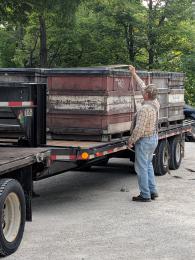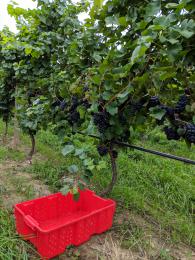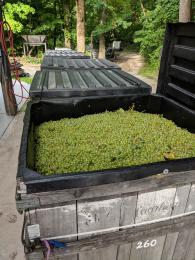2018 Harvest Update: October 15th
As I look outside the window, it’s noteworthy that the trees are still mostly green, with just a few splashes of color showing. It’s is mid-October and by now we are usually at, or approaching, the traditional peak fall color time. With the warm weather and high humidity we’ve had, the trigger for deciduous leaves to turn color and fall off the tree hasn’t completely arrived. The last part of the week, though, has seen a shift into more typical fall weather. The temperatures have dropped into the 40’s and 50’s creating what could best be described as a big refrigerator for the grapes. The sun is mostly hidden behind clouds (with a few exceptional days), so little ripening is happening in these conditions—it is too cold and too sunless. At the same time, molds, mildews, insects, and other disease organisms are also tamped down, removing some of the pressure we were feeling before to harvest before too much rot sets in.
The plan now is to take in what has to be taken in and let the rest hang if they are still sound. There are sunny days ahead in the forecast, and as long as the leaves are still green and capable of photosynthesizing, we can still gain some nice ground with achieving riper flav ors. The picture of Cabernet Franc in the Szklenski Brothers’ well-managed vineyards shows a balanced crop load, exposed fruit, and a clean vineyard floor that allows good air movement through the vines. What isn’t seen in the photo is that because of the heat and humidity in the days just prior to this photo, Botrytis is starting to develop on some of the clusters. The weather forecast was for a period of rain, which would have allowed the Botrytis to take over, so we harvested this vineyard the next day to avoid losing quality. If the weather had held, the vines would have been in great shape to continue ripening. We would have loved to keep these grapes hanging longer, but such are the choices we must make sometimes.
ors. The picture of Cabernet Franc in the Szklenski Brothers’ well-managed vineyards shows a balanced crop load, exposed fruit, and a clean vineyard floor that allows good air movement through the vines. What isn’t seen in the photo is that because of the heat and humidity in the days just prior to this photo, Botrytis is starting to develop on some of the clusters. The weather forecast was for a period of rain, which would have allowed the Botrytis to take over, so we harvested this vineyard the next day to avoid losing quality. If the weather had held, the vines would have been in great shape to continue ripening. We would have loved to keep these grapes hanging longer, but such are the choices we must make sometimes.
I had a conversation with another local winemaker who buys from some of the same vineyards we do. Both of us have seen conditions in other Eastern US regions, and we both agree that our local vineyards have been very fortunate this season by comparison. Most other areas in the East are having a much harder harvest than we have had, with excessive rain and accompanying disease pressure.
Bob Green
PIWC Executive Winemaker



 ther lets us. With cooler temperatures, we’ll need ample sunlight to continue the ripening process, developing the desired flavors in the fruit. Rain is in the forecast, and it will now be a dance with the weather to determine to the right time for harvesting these late-season varieties.
ther lets us. With cooler temperatures, we’ll need ample sunlight to continue the ripening process, developing the desired flavors in the fruit. Rain is in the forecast, and it will now be a dance with the weather to determine to the right time for harvesting these late-season varieties.

